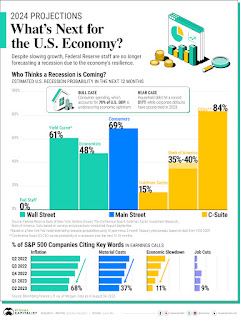
Wall Street Cheers on Santa Rally as S&P 500 Eyes Eighth Straight Win
It's been a wild ride for the markets in 2023, but as we approach the holidays, things are finally looking up. The S&P 500 is on track for a remarkable eighth straight winning week, fueled by cooling inflation data and optimism for a year-end rally. But before we pop the champagne corks, let's take a closer look at how the markets have fared so far this year.
A Rocky Road: 2023's Market Rollercoaster
The year started off on a sour note, with the S&P 500 plummeting 9% in January on fears of rising interest rates and a potential recession. The war in Ukraine added further uncertainty, sending stocks into a tailspin. By June, the index had lost nearly 20% of its value, marking its worst first half since 1970.
But then, the winds began to shift. A series of better-than-expected economic reports and signs of easing inflation pressure sparked a comeback rally. By mid-October, the S&P 500 had clawed back most of its losses, and by December, it was even flirting with new highs.
Santa Rally Arrives Early?
The recent surge has been fueled by several factors:
- Cooling inflation: November's CPI data came in lower than expected, suggesting that the Fed's aggressive rate hikes may be starting to work.
- Positive earnings surprises: Many companies have reported better-than-expected earnings, particularly in tech and healthcare sectors.
- Optimism for a soft landing: Investors are hoping that the Fed can engineer a soft landing for the economy,avoiding a recession.
Of course, there are still risks on the horizon. Geopolitical tensions remain high, and a potential winter surge in COVID-19 cases could dampen economic activity. But for now, the mood on Wall Street is decidedly upbeat.
S&P 500 Eyes Historic Winning Streak
Friday's positive performance could extend the S&P 500's winning streak to a remarkable eight weeks. This would be the longest such streak since 2017, and a welcome sign for investors who have been battered by the volatility of the past year.
Looking Ahead: What's Next for the Markets?
Whether the current rally has legs or is just a temporary blip remains to be seen. The Fed's next policy meeting in December will be closely watched, as investors await any clues about the future path of interest rates.
But for now, investors are happy to celebrate the return of the Santa Rally. After a tough year, a little holiday cheer on Wall Street is certainly welcome.
In Conclusion
The markets have been on a wild ride in 2023, but as we head into the holidays, things are finally looking up. The S&P 500 is on track for a remarkable eighth straight winning week, fueled by cooling inflation data and optimism for a year-end rally. While there are still risks on the horizon, the mood on Wall Street is decidedly upbeat. Only time will tell if the current rally has legs or is just a temporary blip, but for now, investors are happy to celebrate the return of the Santa Rally.
I hope this blog article provides a helpful overview of the markets' performance in 2023 and the factors driving the recent rally. Please feel free to leave a comment below with your thoughts on the markets or any questions you may have.
Disclaimer: This blog article is for informational purposes only and should not be considered financial advice. Please consult with a qualified financial advisor before making any investment decisions.













